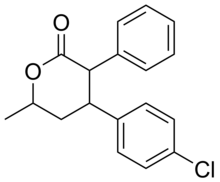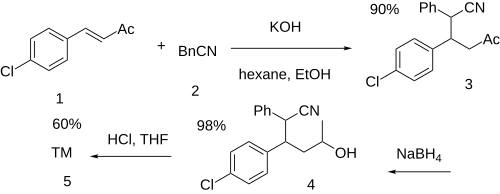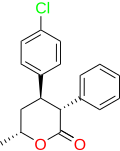 | |
| Clinical data | |
|---|---|
| ATC code |
|
| Identifiers | |
IUPAC name
| |
| CAS Number |
|
| PubChem CID | |
| ChemSpider | |
| UNII | |
| CompTox Dashboard (EPA) | |
| Chemical and physical data | |
| Formula | C18H17ClO2 |
| Molar mass | 300.78 g·mol |
| 3D model (JSmol) | |
SMILES
| |
Lomevactone (INN; developmental code name DR-250) is a drug described as a psychostimulant and antidepressant which was synthesized and assayed in the 1980s, but was never marketed.
Stereoisomers
There are eight possible stereoisomers of lomevactone. It is the (3R,4R,6R)-form that has the psychotherapeutic properties.
Synthesis
The conjugate 1,4-alkylation reaction between 4-chlorobenzylideneacetone (1) and phenylacetonitrile (2) gives 3-(4-chlorophenyl)-5-oxo-2-phenylhexanenitrile (3). The selective reduction of the keto group to the alcohol with sodium borohydride gives 3-(4-chlorophenyl)-5-hydroxy-2-phenylhexanenitrile (4). Hydrolysis of the nitrile to an acid gives 3-(4-chlorophenyl)-5-hydroxy-2-phenylhexanoic acid. This is followed by lactone formation completing the synthesis of lomevactone (5).

References
- David J. Triggle (1997). Dictionary of pharmacological agents. London: Chapman & Hall. ISBN 0-412-46630-9.
- Poncelet M, Chermat R, Soubrie P, Simon P (1983). "The progressive ratio schedule as a model for studying the psychomotor stimulant activity of drugs in the rat". Psychopharmacology. 80 (2): 184–9. doi:10.1007/BF00427967. PMID 6136063. S2CID 2372145.
- Axiotis, S.; Druex, J.; Perrin, M.; Royer, J. (1982). "Conformations in the tetrahydropyran-2-one ring". Tetrahedron. 38 (4): 499–504. doi:10.1016/0040-4020(82)80093-8.
- Axiotis, S., Sollier, J.-C., Dreux, J., Chermat, R., Poncelet, M., Simon, P. (July 1987). "Tétrahydropyrones-2 III. Recherche d'une activité psychostimulante spécifique". European Journal of Medicinal Chemistry. 22 (4): 293–303. doi:10.1016/0223-5234(87)90266-2.
- Axiotis, S. et al, Eur. J. Med. Chem.-Chim. Ther., 1981, 16, 431, 439.
- Pierre Simon & Jacques Dreux, U.S. patent 4,287,206 (1981 to Sanofi Aventis France).
- 시몽 삐에르 & 드로 짝끄, KR830002288 (1983).
| Stimulants | |
|---|---|
| Adamantanes | |
| Adenosine antagonists | |
| Alkylamines | |
| Ampakines | |
| Arylcyclohexylamines | |
| Benzazepines | |
| Cathinones |
|
| Cholinergics |
|
| Convulsants | |
| Eugeroics | |
| Oxazolines | |
| Phenethylamines |
|
| Phenylmorpholines | |
| Piperazines | |
| Piperidines |
|
| Pyrrolidines | |
| Racetams | |
| Tropanes |
|
| Tryptamines | |
| Others |
|
| ATC code: N06B | |
This drug article relating to the nervous system is a stub. You can help Misplaced Pages by expanding it. |
